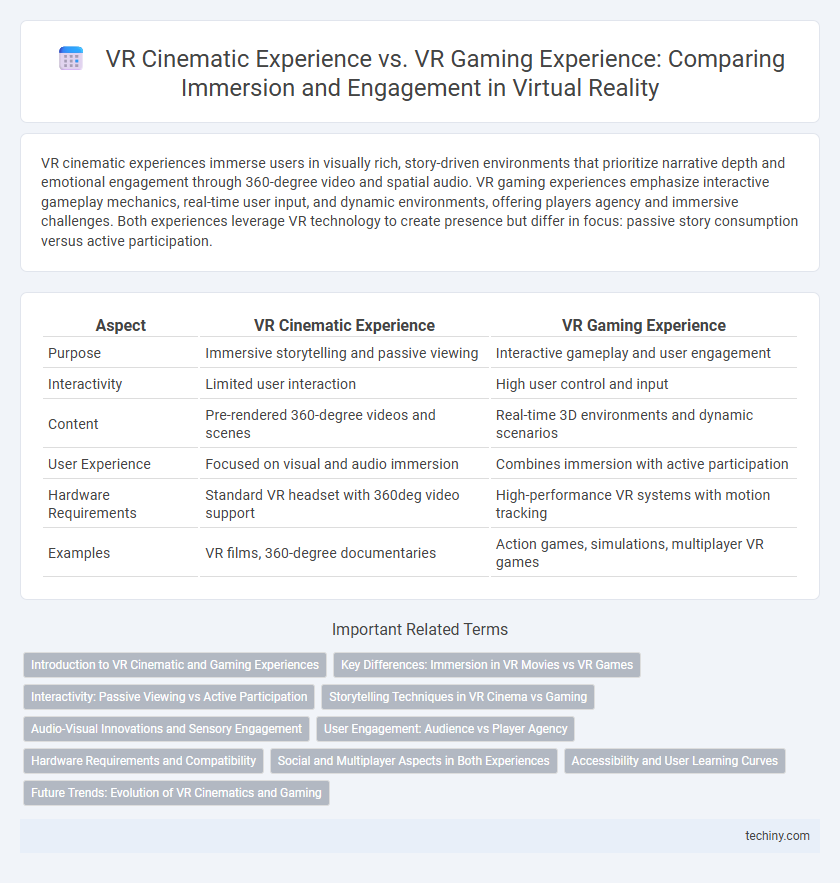VR cinematic experiences immerse users in visually rich, story-driven environments that prioritize narrative depth and emotional engagement through 360-degree video and spatial audio. VR gaming experiences emphasize interactive gameplay mechanics, real-time user input, and dynamic environments, offering players agency and immersive challenges. Both experiences leverage VR technology to create presence but differ in focus: passive story consumption versus active participation.
Table of Comparison
| Aspect | VR Cinematic Experience | VR Gaming Experience |
|---|---|---|
| Purpose | Immersive storytelling and passive viewing | Interactive gameplay and user engagement |
| Interactivity | Limited user interaction | High user control and input |
| Content | Pre-rendered 360-degree videos and scenes | Real-time 3D environments and dynamic scenarios |
| User Experience | Focused on visual and audio immersion | Combines immersion with active participation |
| Hardware Requirements | Standard VR headset with 360deg video support | High-performance VR systems with motion tracking |
| Examples | VR films, 360-degree documentaries | Action games, simulations, multiplayer VR games |
Introduction to VR Cinematic and Gaming Experiences
Virtual Reality cinematic experiences immerse users in visually rich, story-driven environments designed to evoke emotional responses through narrative and high-quality visuals. VR gaming experiences prioritize interactivity, offering dynamic gameplay that responds to user actions within a fully navigable 3D space. Both leverage advanced VR hardware like headsets and motion controllers but differ fundamentally in objective: cinematic VR aims to captivate through storytelling, while gaming emphasizes player agency and engagement.
Key Differences: Immersion in VR Movies vs VR Games
VR cinematic experiences prioritize passive immersion through narrative-driven visuals and soundscapes that engage viewers emotionally, offering a controlled environment for storytelling. In contrast, VR gaming experiences demand interactive immersion, where users actively influence the virtual world through movement and decision-making, creating a dynamic and personalized engagement. The key difference lies in the level of user agency and interactivity, with VR games fostering participatory immersion while VR movies emphasize sensory and emotional involvement.
Interactivity: Passive Viewing vs Active Participation
VR cinematic experiences offer immersive storytelling through passive viewing, allowing users to observe narratives unfold within 360-degree environments without influencing the plot. VR gaming experiences prioritize active participation, engaging users in interactive gameplay that requires decision-making, physical movement, and problem-solving within virtual worlds. The distinction between passive immersion in VR cinema and dynamic engagement in VR gaming defines their respective interactivity levels and user involvement.
Storytelling Techniques in VR Cinema vs Gaming
VR cinematic experiences employ carefully crafted narratives with controlled pacing and immersive environmental storytelling to evoke deep emotional responses, leveraging pre-designed scenes and character-driven plots. In contrast, VR gaming integrates interactive storytelling where player choices and actions influence the narrative flow, creating dynamic and personalized story arcs through real-time engagement. Both mediums utilize spatial audio, visual cues, and 360-degree perspectives but diverge in authorship control, with cinema guiding viewers along a fixed narrative path while gaming fosters exploratory storytelling shaped by user agency.
Audio-Visual Innovations and Sensory Engagement
VR cinematic experiences leverage advanced spatial audio and photorealistic visuals to immerse viewers in a narrative environment, emphasizing story-driven sensory engagement through dynamic soundscapes and detailed imagery. VR gaming experiences integrate interactive audio cues and real-time visual feedback, enhancing player agency and presence by synchronizing haptic responses with environmental changes. These audio-visual innovations create distinct sensory engagement layers, with cinematic VR focusing on emotional immersion and gaming VR prioritizing interactive responsiveness.
User Engagement: Audience vs Player Agency
VR cinematic experiences prioritize audience engagement through immersive storytelling and controlled narratives, guiding users through a visually rich environment designed to evoke emotional responses. VR gaming experiences emphasize player agency, allowing interactive decision-making and freedom within the virtual world to enhance engagement and personal investment. User engagement in VR hinges on balancing passive immersion in cinematic content with active participation in gaming scenarios to cater to diverse user preferences.
Hardware Requirements and Compatibility
VR cinematic experiences prioritize high-resolution displays and advanced audio systems to deliver immersive storytelling, requiring hardware that supports 4K or higher video playback and spatial sound processing. VR gaming experiences demand more powerful GPUs, higher refresh rates (90Hz or above), and responsive motion tracking systems to ensure fluid interactivity and low latency. Compatibility for cinematic VR often extends to media players and streaming platforms, whereas gaming VR requires seamless integration with game engines and controllers like Oculus Touch or Valve Index.
Social and Multiplayer Aspects in Both Experiences
VR cinematic experiences provide immersive storytelling where social interaction often revolves around shared viewing and real-time audience reactions, fostering a communal sense of presence. VR gaming experiences emphasize dynamic multiplayer engagement, enabling cooperative gameplay, competitive matches, and rich player-to-player communication that enhance social connectivity. Both platforms leverage spatial audio and avatar interactions to create authentic social environments, but gaming typically offers more interactive and sustained social dynamics.
Accessibility and User Learning Curves
VR cinematic experiences offer intuitive accessibility with minimal user interaction, allowing users to immerse themselves in storytelling without complex controls. In contrast, VR gaming requires a steeper learning curve due to interactive mechanics, spatial navigation, and gameplay strategies. This difference impacts user engagement, with cinematic VR appealing to casual users while gaming VR targets experienced players seeking active participation.
Future Trends: Evolution of VR Cinematics and Gaming
Future trends in VR cinematic experiences emphasize hyper-realistic storytelling through AI-driven environments and real-time rendering, enhancing immersion and emotional engagement. VR gaming experiences are advancing with adaptive gameplay mechanics powered by machine learning, enabling personalized challenges and intuitive interactions. Both sectors increasingly integrate cloud computing and 5G technology to deliver seamless, high-fidelity experiences with expansive content libraries.
VR Cinematic Experience vs VR Gaming Experience Infographic

 techiny.com
techiny.com